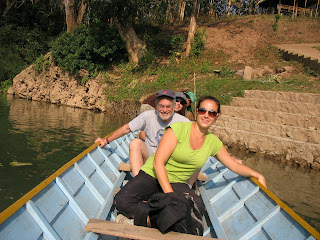
(I didn't actually ride it as I knew I'd hurt somebody if I did.)
I wondered how traveling alone would go for me at age 56. (56?!) Before leaving, I worried about issues that never crossed my mind in my 20’s, when one, two, or three months a year, I would be “on the road.” Would I get claustrophobic and panicky on the long plane ride to Asia? (got a prescription for lorazepam) Would the heat be too much for me? What about the language barrier and having nobody to travel with? Would this whole “adventure” be an ordeal of loneliness? Never before had so much real estate in my backpack been devoted to pills. Diarrhea, constipation, nose sprays, malaria, sleeping, motion sickness…….oy.
Fortunately, from the moment I got into my seat on Japan Airlines – complete with a personal TV screen for movies and games, meal followed by snack followed by meal, I somehow knew anxieties would pose no problems. As it turned out, neither anxieties nor loneliness ever clouded my travel-days. Every morning I awoke excited, wondering what would unfold and who I would meet. I interacted with so many different folks though the majority of travelers were young. I left those thoughts of being a 56 year-old back at the birthday brunch we’d had two days before my departure. Nevertheless, there were a few times when my age hit me like an ice pack on a sore knee and gave me pause. In those hours, I remembered that at my corporeal “north pole,” there was a thinning crop of gray hair announcing my advanced “stage of life.”
One night in a tiny Chiang Mai bar near my guesthouse, I got into a bar-side conversation with a British guy where everything out of our mouths sounded ultra-clever, astute and hilarious. Whether the subject was politics, music, or Bangkok, we had each other laughing and nodding emphatically. About an hour into it, he mentioned that he’d lived briefly in Santa Barbara when his dad got a teaching position at UCSB. I got quite excited, as I’d graduated from UCSB. I wondered what his dad had taught. Wouldn’t it have been wild if I had been his student?
“What year was it?” I asked.
“It was 1977.” he answered.
“Oh, I was already gone at that point. I graduated in ’74.”
“1974!! That was before I was born.”
That last reply did not get me laughing. Instead it got my brain wheels moving to a private space, wondering who my bar friend was seeing throughout our conversation. Was I like a professor colleague of his father’s or maybe an old family friend of his parents’ generation who is easy to talk to?
The last couple of days of my trip were in Bangkok, Thailand - from where my return flight would leave. I stayed near the ultra-modern Skytrain which could get me almost anywhere I wanted to go – what with some walking. It was also just off Sukhumvit Road which is lined with young prostitutes for probably a mile in either direction from the hostel where I stayed. It was unsettling to see the dozens of older white men who walked hand in hand or obviously in “relationship” with a Thai prostitute less than half his age and weight. You’d see a lot of these couples in the restaurants with nothing to say to each other. Often the girl might be on her cell phone while the older guy occupied himself with the details of the restaurant walls or ceiling. The arrangement in Bangkok was one in which the two would keep company for 12 or 24+ hours at a time. Even if there were no language barrier, many of these guys had to deal with the fact they had no communications skills. Most of them also avoided eye contact with tourist families and couples who were not in a “rental” situation.
On the plane from Vientiane to Bangkok, I was seated next to a pretty, blonde 28 year-old backpacker. She was engaged to be married, but decided to go traveling for awhile before planning a wedding. She hadn’t made a guesthouse reservation. She asked if she might come with me to see if my hostel had room for her. We ended up spending much of my final two days together, touring in the mornings and getting back together for dinner in the evenings, yakking and yukking up a storm. One night we were on the Skytrain and I caught our reflection in a mirror across from us. It gave me a start. There’s no question that there was an older man – albeit with a cool, celestial shirt and big smile punctuating his ancient skull – sitting next to a surfer girl. An image of those Sukhumvit Johns buzzed my brain before I could look away.
You may ask what does it matter if I appeared to be an older man; of another generation; not in his virile, dark, curly-haired prime? Does it change any of the enjoyable interaction I had with her, or any other young travelers I’d spent time with? Granted I’ve done a lot more aging than evolving as a man. Who has time to evolve when it feels that someone “in charge” leaned on the “fast forward” button on my life and forgot to let up? But I hope that at least a lot of other 50-somethings (and older) would understand, and not just my sad, paunchy cousins down below on Sukhumvit Road.

Coming back from a trek I did with a sister and brother from Canada.
















